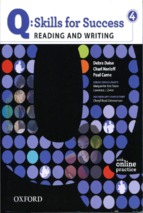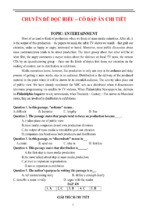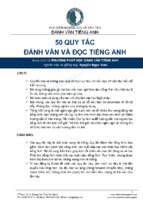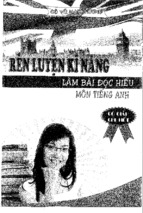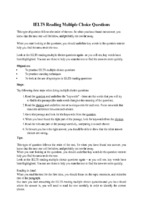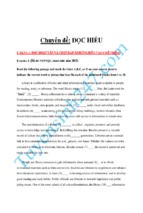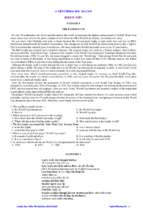encyclopedia of
Biology
ENCYCLOPEDIA OF
biology
don rittner
Timothy
and
L. McCabe,
Ph.D.
Encyclopedia of Biology
Copyright © 2004 by Don Rittner
All rights reserved. No part of this book may be reproduced or utilized in any form or by any
means, electronic or mechanical, including photocopying, recording, or by any information storage
or retrieval systems, without permission in writing from the publisher. For information contact:
Facts On File, Inc.
132 West 31st Street
New York NY 10001
Library of Congress Cataloging-in-Publication Data
Rittner, Don.
Encyclopedia of biology / Don Rittner and Timothy L. McCabe.
p. cm.
Summary: Contains approximately 800 alphabetical entries, prose essays on important topics, line
illustrations, and black-and-white photographs.
Includes bibliographical references (p. ).
ISBN 0-8160-4859-2
1. Biology—Encyclopedias, Juvenile. [1. Biology—Encyclopedias.
2. Encyclopedias and dictionaries.] I. McCabe, Timothy Lee. II. Title.
QH309.2.R58 2004
570’.3—dc222003021279
Facts On File books are available at special discounts when purchased in bulk quantities for
businesses, associations, institutions, or sales promotions. Please call our Special Sales Department
in New York at (212) 967-8800 or (800) 322-8755.
You can find Facts On File on the World Wide Web at http://www.factsonfile.com
Text design by Joan M. Toro
Cover design by Cathy Rincon
Illustrations by Richard Garratt and Sholto Ainslie
Printed in the United States of America
VB FOF 10 9 8 7 6 5 4 3 2 1
This book is printed on acid-free paper.
Dedicated to
Louis F. Ismay and John F. Roach
Two superb teachers who taught me to always ask why
and to my family
Nancy, Christopher, Kevin, Jackson, Jennifer, & Jason
CONTENTS
Acknowledgments
ix
Preface
xi
Introduction
xiii
Entries A–Z
1
Feature Essays:
“Blood Identification through the Ages”
by John C. Brenner and Demetra Xythalis
44
“Human Cytogenetics: Historical Overview and
Latest Developments”
by Betty Harrison
67
“The Karner Blue—New York’s Endangered Butterfly”
by Robert Dirig
111
“Insects and Man—An Exotic Dilemma”
by Timothy L. McCabe, Ph.D.
158
“Science and the Spiritual Factor”
by John McConnell
170
“Silk Degrees: A Tale of Moths and People, Part One”
by James G. (Spider) Barbour
200
“Sassafras and Its Lepidopteran Cohorts, or Bigger and Better Caterpillars
through Chemistry”
by Timothy L. McCabe, Ph.D.
202
“Silk Degrees: A Tale of Moths and People, Part Two”
by James G. (Spider) Barbour
228
“Egyptian Mummies: Brief History and Radiological Studies”
by William A. Wagle, M.D.
233
Appendixes:
Appendix I
Bibliography
357
Appendix II
Biology-Related Websites
363
Appendix III
Biology Software and Animations Sources
365
Appendix IV
Nobel Laureates Relating to Biology
367
Appendix V
Periodic Table of the Elements
377
Appendix VI
Biochemical Cycles
379
Appendix VII
The “Tree of Life”
381
Index
383
ACKNOWLEDGMENTS
We would like to thank the following for their generosity in helping to
make this book as complete as possible, especially in the use of images,
biographies, essays, and encouragement: Darryl Leja, NHGRI, National
Institutes of Health, for wonderful illustrations; Marissa Mills, Human
Genome Management Information System, Oak Ridge National Laboratory, U.S. Department of Energy Genomes to Life Program; Celia Boyer,
executive director, Health On the Net (HON) Foundation; Kristina Fallenias, Nobel Foundation; Fabienne Meyers, International Union of Pure
and Applied Chemistry; Robert Dirig, Cornell University; Centers for Disease Control; William and Greta Wagle; John McConnell; John C. Brenner; Demetra Xythalis; Joseph Deuel, Petrified Sea Gardens, Inc.; Betty
Harrison; James G. (Spider) Barbour; Hideki Horikami; Thomas Wittling;
and to Nancy, Chris, Kevin, and Jack.
Finally, thanks to Frank K. Darmstadt, our very patient editor, and the
rest of the staff at Facts On File for their contributions.
We apologize to anyone left out in error.
ix
PREFACE
Despite the often extreme specialization and intimate knowledge required
to make a contribution to science, most scientific disciplines are quick to
adapt new technologies and advances developed from other fields.
Inevitably, a new vocabulary follows these advances, the purpose of which
is to convey meaning with a word that once required a descriptive paragraph or even a page.
The Encyclopedia of Biology pulls together the specialized terminology that has found its way into the language of the biologist. It addresses
the often duplicitous meanings in an easily understood, succinct fashion.
As each discipline has become more of a specialty, each has developed
terms that serve as a shorthand for concepts within that discipline. On rare
occasion, different disciplines develop the same term with radically different definitions. By indicating a discipline, the encyclopedia directs the
reader to a definition relevant to the topic at hand. An example of this is
the word genotype. Historically, this was a taxonomist’s term meaning
“the type of the genus.” The genotype is important for classification and
evolutionary studies. Subsequently, geneticists used genotype to refer to
the genetic makeup of an organism. One needs to understand not only the
meaning of words, but must also be able to put them in the context of the
period in which they were written.
There will be new terms, new (and defunct) science Websites, new
leaders, new disciplines, and even breathtaking new discoveries in science,
but these will not detract from the utility of this encyclopedia. Bibliophiles
need only pause to consider which books they consult most frequently.
The reference book holds counsel over all others. Facts On File’s Encyclopedia of Biology may not read like a novel, but it will help you read like a
biologist.
—Tim McCabe, Ph.D.
xi
INTRODUCTION
Facts On File’s Encyclopedia of Biology is a reference to help in understanding the basic concepts in biology and its peripheral disciplines like
ecology, botany, and even Earth science. Arranged in alphabetical order,
the entries include biographies of individuals who have made major contributions as well as numerous line illustrations and photographs to help in
visualizing technical concepts.
I have tried to include the more common terms you will likely
encounter during your educational experience or even when you are out in
the “real” world. There are literally thousands of biological terms. Many
are so specific to major or minor subdisciplines of biology that you may
never encounter them. You will not find those esoteric terms in this encyclopedia but, rather, a collection of terms that you should be familiar with
to understand core biological principles and have a working knowledge of
the field. You can also use this volume simply to increase your scientific
vocabulary. A series of well-placed essays elaborate on some of the most
important trends and issues in the field. One of these describes how the use
of computer technology has revealed an artificial toe in a mummy that is
thousands of years old. You will also learn how blood is used in forensic
science to capture criminals and read about the latest trends in human
cytogenetics. Other essays will make you think about your role in the
world and explore some of the negative effects we humans have had on the
biological world, in particular to the insect family.
The encyclopedia also includes appendixes with information about
Internet Websites and biology-related software that is waiting for you to
explore.
We humans are part of this immense biological world, and we interact
with it in many ways. Some of those interactions have cost species their
very existence. Some have helped us survive disease. In other cases, we
have helped species come back from the brink of extinction. This complex
interrelationship is not clearly understood even today, and that is why
many who use this book are pursuing some aspect of biology as a career.
We have come a long way from Robert Hooke’s first observation of a
cell under a crude microscope to today’s observations of atomic-level
activity using electron microscopes. The use of computer science and technology has enabled huge leaps in our understanding of our biological
xiii
xiv
Introduction
world. The future hope of nanotechnology, using small robots to scurry
through our bodies to fix organs or cure disease, is closer to becoming
reality than it is to fiction. Other former sci-fi issues, like cloning humans,
are on the forefront of discussion, and some have even claimed human
cloning has happened. The mapping of our entire genetic makeup brings
promise to thousands of people who have or carry genetically based disease. This has led at least one scientist to declare that we are moving into
the “industrial revolution of biology,” anticipating the exciting discoveries
just around the corner from the analysis of all this genetic information.
We are entering a world of molecular understanding of developmental
biology all the way to the enigma of consciousness. But you cannot leap
without first taking small steps. Use this book for the small steps, and
heed the words of Cornell biologist James G. Needham (1888–1957),
who once wrote:
It is a monstrous abuse of the science of biology to teach it only in
the laboratory—Life belongs in the fields, in the ponds, on the
mountains, and by the seashore.
So, armed with this book, consider that your next assignment.
—Don Rittner
Schenectady, New York
ENTRIES A–Z
A
ABO blood groups Blood group antibodies (A, B,
This hormone also acts as a stress agent that helps
a plant deal with adverse conditions. For example,
ABA accumulates on leaves and causes stomata to
close, reducing the loss of water when a plant begins to
wilt.
In 1963, abscisic acid was first identified and characterized by Frederick Addicott and colleagues. In
1965, the chemical structure of ABA was defined, and
in 1967, it was formally called abscisic acid.
AB, O) that may destroy red blood cells bearing the antigen to which they are directed; also called “agglutinins.”
These red-cell antigens are the phenotypic expression of
inherited genes, and the frequency of the four main
groups varies in populations throughout the world.
The antigens of the ABO system are an integral part of
the red-cell membrane as well as all cells throughout the
body and are the most important in transfusion practice.
See also LANDSTEINER, KARL.
absorption spectrum Different pigments absorb
light of different wavelengths. For example, chlorophyll effectively absorbs blue and red. The absorption
spectrum of a pigment is produced by examining,
through the pigment and an instrument called a spectroscope, a continuous spectrum of radiation. The
energies removed from the continuous spectrum by the
absorbing pigment show up as black lines or bands and
can be graphed.
abortion The termination of gestation before the
fetus can survive on its own.
abscisic acid (ABA) A plant hormone (C15H20O4)
and weak acid that generally acts to inhibit growth,
induces dormancy, and helps the plant tolerate stressful
conditions by closing stomata. Abscisic acid was
named based on a belief that the hormone caused the
abscission (shedding) of leaves from deciduous trees
during the fall.
At times when a plant needs to slow down growth
and assume a resting (dormant) stage, abscisic acid is
produced in the terminal bud, which slows down
growth and directs the leaf primordia to develop scales
that protect the dormant bud during winter. Because
the hormone also inhibits cell division in the vascular
cambium, both primary and secondary growth are put
on hold during winter.
abyssal zone The portion of the ocean floor below
1,000–2,000 m (3,281–6,561 ft.), where light does not
penetrate and where temperatures are cold and pressures are intense. It lies seaward of the continental
slope and covers approximately 75 percent of the
ocean floor. The temperature does not rise above 4°C.
Because oxygen is present, a diverse community of
invertebrates and fishes do exist, and some have adapted to harsh environments such as hydrothermal vents
1
2
acclimatization
of volcanic creation. Food-producing organisms at this
depth are chemoautotrophic prokaryotes and not photosynthetic producers.
See also OCEANIC ZONE.
shared the 1953 Nobel Prize in physiology or medicine
with HANS KREBS.
See also KREBS CYCLE.
achiral See CHIRALITY.
acclimatization
Acclimatization is the progressive
physiological adjustment or adaptation by an organism to a change in an environmental factor, such as
temperature, or in conditions that would reduce the
amount of oxygen to its cells. This adjustment can
take place immediately or over a period of days or
weeks. For example, the human body produces more
erythrocytes (red blood cells) in response to low partial pressures of oxygen at high altitudes; short-term
responses include shivering or sweating in warmblooded animals.
accommodation The automatic reflex adjustment
that allows the focal length of the lens of an eye to
change to focus on an object. The lens shape, more
convex for near objects and less convex for distant
objects, is caused by ciliary muscles acting on the elastic property of the lens.
acid A chemical capable of donating a HYDRON (proton, H+) or capable of forming a covalent bond with
an electron pair. An acid increases the hydrogen ion
concentration in a solution, and it can react with certain metals, such as zinc, to form hydrogen gas. A
strong acid is a relatively good conductor of electricity.
Examples of strong acids are hydrochloric (muriatic),
nitric, sulfuric, while examples of mild acids are sulfurous and acetic (vinegar). The strength of an acidic
solution is usually measured in terms of its pH (a logarithmic function of the H+ ion concentration). Strong
acid solutions have low pHs (typically around 0–3),
while weak acid solutions have pHs in the range 3–6.
See also BASE; PH SCALE.
acidity constant The equilibrium constant for splitting off a HYDRON from a BRØNSTED ACID.
acetylcholine (ACh) One of the most common
neurotransmitters of the vertebrate nervous system,
ACh is a chemical (CH3COOCH2CH2N+(CH3)3) that
transmits impulses between the ends of two adjacent
nerves or neuromuscular junctions. Released by nerve
stimulation (exciting or inhibiting), it is confined largely to the parasympathetic nervous system, where it diffuses across the gap of the synapse and stimulates the
adjacent nerve or muscle fiber. It rapidly becomes inactive by the enzyme cholinesterase, allowing further
impulses to occur.
acetyl CoA A compound formed in the mitochondria when the thiol group (–SH) of coenzyme A combines with an acetyl group (CH3CO–). It is important
in the Krebs cycle in cellular respiration and plays a
role in the synthesis and oxidation of fatty acids.
Fritz Albert Lipmann (1899–1986), a biochemist,
is responsible for discovering coenzyme A and cofactor
A, or CoA (A stands for acetylation), in 1947. He
acid-labile sulfide Refers to sulfide
LIGANDs,
the BRIDGING LIGANDs in IRON–SULFUR
which are released as H2S at acid pH.
See also FERREDOXIN.
e.g.,
PROTEINS,
acid precipitation Because pure precipitation (e.g.,
rain) is slightly acidic (due to the reaction between
water droplets and carbon dioxide, creating carbonic
acid) with a potential pH of 5.6, acid precipitation
refers to precipitation with a pH less than 5.6. Acid
precipitation includes rain, fog, snow, and dry deposition. Anthropogenic (man-made) pollutants (carbon
dioxide, carbon monoxide, ozone, nitrogen and sulfur
oxides, and hydrocarbons) react with water vapor to
produce acid precipitation. These pollutants come primarily from burning coal and other fossil fuels. Sulfur
dioxide, which reacts readily with water vapor and
droplets (i.e., has a short residence time in the atmosphere as a gas), has been linked to the weathering
actin
3
(eating away) of marble structures and the acidification of freshwater lakes (consequently killing fish).
Natural interactions within the biosphere can also lead
to acid precipitation.
acoelomate
A solid-bodied animal lacking a body
cavity, the space between the gut (digestive tract) and
body wall. Simple animals do not have a body cavity
as higher animals do; this body cavity is called a
coelom in mammals and contains the gut (a cavity by
itself), heart, and lungs, for example. Acoelomates are
bilateral animals and are triploblastic (have three layers: ectoderm, endoderm, and mesoderm). They can
move forward and have a degree of cephalization
(centralization of neural and sensory organs in the
head).
Representative phyla of acoelomates are the Platyhelminthes: flatworms that include the Turbellaria
(nonconfined flatworms such as planarians), Monogenea (monogeneans), Trematoda (trematodes, or flukes),
and Cestoidea (tapeworms). There are more than
20,000 species of flatworms living in wet environments
such as marine or freshwater bodies and damp terrestrial areas.
See also COELOM.
aconitase A name for citrate (isocitrate) hydro-LYASE
(aconitate hydratase), which catalyzes the interconversion of citrate, cis-aconitate ((Z)-prop-1-ene-1,2,3-tricarboxylate), and isocitrate. The active ENZYME
contains a catalytic [4FE-4S] CLUSTER.
Mariposa lily from California. An example of an actinomorphic,
radially symmetrical flower. (Courtesy of Tim McCabe)
contact with the egg help the sperm head penetrate the
egg for fertilization. Directly behind the acrosome is the
haploid nucleus (single set of unpaired chromosomes)
that contains the genetic material.
See also FERTILIZATION.
actin A globular protein found in muscle tissue as
acrosome The acrosome is a special area or compartment that is located at the tip of the head of a
sperm cell. It contains special digestive enzymes that on
acrosome
The acrosome is a special area or compartment that is located at
the tip of the head of a sperm cell.
thin filaments and in microfilaments that form portions
of cell cytoskeletons. Actin links into chains, and
paired chains twist helically around each other, forming
microfilaments in muscle and other contractile elements
in cells. Actin and myosin filaments interact to initiate
muscle contraction.
Tropomyosin and troponin are two protein
molecules associated with actin filaments in muscle.
Tropomyosin runs along the length of the actin filament and covers the area of the actin molecule that
interacts with myosin when at rest. On the other hand,
when a muscle is contracted, tropomyosin is replaced
with troponin as it binds to calcium ions. Troponin is
- Xem thêm -




